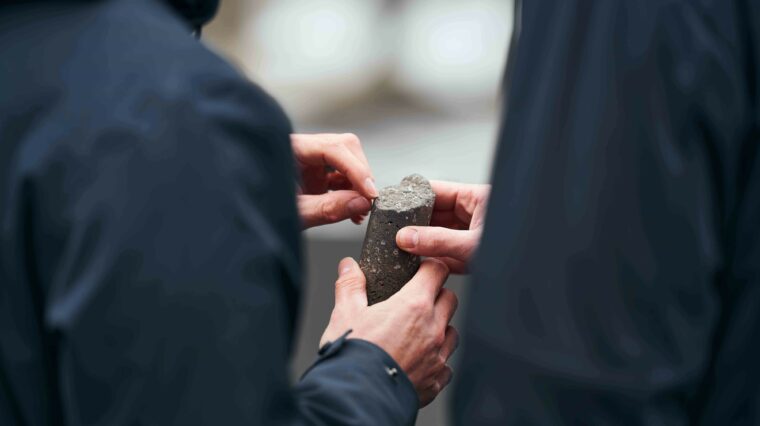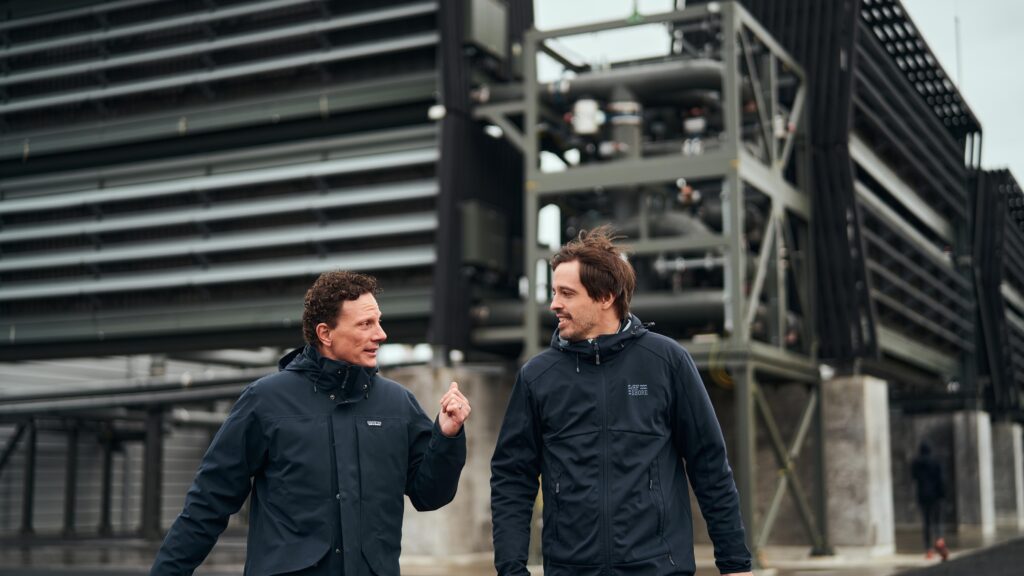🇮🇸 The future in your hands: Iceland pioneering carbon direct-air capture
Press release from the Nordic Investment Bank

Climate change, often perceived as an abstract and complex subject, becomes strikingly concrete in Iceland, just 30 minutes southeast of Reykjavik. Here, next to the Hellisheiði geothermal power plant, the remarkable Orca facility actively pulls carbon dioxide (CO₂) from the atmosphere, anchoring it deep within the earth’s crust and converting it into rock.
With its rich reserves of geothermal energy and ideal basalt rock formations, Iceland is uniquely positioned to lead in carbon dioxide storage solutions. Making smart use of what you’ve got can indeed pave the way for small nations like Iceland in mitigating global challenges.
In 2021, the Swiss climate tech company Climeworks launched the pioneering Orca plant, the world’s first and still the only direct air capture and storage plant. The name of the plant is after the Icelandic word for energy “orka” and is a partnership with the innovation company Carbfix mineralising the carbon dioxide and ON Power providing electricity from its Hellisheiði Geothermal Power Plant. Both are subsidiaries of the municipal energy company Orkuveita Reykjavikur, a client of the Nordic Investment Bank.
Together, Climeworks and Carbfix are global leaders in carbon dioxide removal via their direct air capture and storage (DAC+S) technology.
“Through our services, we empower companies to advance their net zero roadmaps and fight global warming,” says Christoph Gebald, co-Founder and co-CEO of Climeworks.

“We aim to achieve a megaton of installed DAC capacity by 2030 and gigaton capacity by 2050. We are currently well on track to lead the global deployment of carbon dioxide removal DAC+S with projects spanning various regions, including the United States, Kenya, Iceland and more.”
Direct air capture
The Orca uses direct air capture (DAC) technology to pull CO2 directly from the atmosphere. Air is first drawn into a collection system using fans. Within this system, a special filter material captures the carbon dioxide. Once the filter becomes saturated with CO2, it’s heated up to between 80-100 Celsius degrees, causing the carbon dioxide to be released in a pure form.
The captured carbon dioxide can then be stored or utilised for various applications, ensuring a reduction in atmospheric carbon dioxide levels. At Orca, the carbon dioxide is sent through pipes to Carbfix, which has developed a reliable method to sequester the CO2.
Impact and scale
So far, the pioneering Orca facility has eliminated about 4,000 tons of CO₂ per year, which is not more than what around 800 fossil fuel cars release annually. However small, this is an important start. According to the Science Based Targets initiative (SBTi) standard, a legitimate net-zero strategy must both reduce emissions reductions and proactively remove CO₂ emissions.
“Our biggest goal is to make a lasting, meaningful impact in the fight against climate change. What constitutes significant impact? According to the latest IPCC report, the world needs to remove several gigatons of carbon dioxide from the atmosphere in 2050. This cannot be done by one solution alone. But direct air capture and storage will have to play a significant role in reaching this target,” Gebald says.
“Thus, we have set ourselves the goal of achieving gigaton-scale carbon removal capacity in 2050. To reach this, attaining megaton capacity in 2030 represents an important waypoint.”
The future is Mammoth
Climeworks currently has a customer base of over 160 companies, including multinationals such as Microsoft and Boston Consulting Group. In May, Climeworks and JPMorgan Chase announced a USD 20 million deal to complement its own efforts to reduce operational emissions and support what they call scalable solutions need for the world to achieve net-zero emissions by 2050.
For now, Climeworks and its Icelandic partners are making strides in constructing a second plant named Mammoth, currently being constructed nearby the Orca plant. The Mammoth is designed with a nominal annual CO₂ capture capacity of 36,000 tonnes when fully operational early in 2024.
A holistic climate solution
While Climeworks and its partners offer a promising method for addressing climate change, it is not one solution to fix it all. Rather, it is one of many tools to reduce global warming.
“Looking at the growth and industrialization rates that have been achieved in the past in other industries, such as the renewable energy industry, we know it has been done before and can be repeated. This said, it is important to emphasize that while DAC is a key component in addressing climate change, the ultimate solution lies in the broader decarbonization of our entire economy. In this regard, we need to do everything we can to reduce emissions by at least 90%, and on top of that actively remove the remaining 10% through high-quality, permanent carbon removal solutions like DAC+S,” Gebald says.
Carbon mineralisation process
The Carbfix process uses nature’s own way of mineralising carbon into rocks. By dissolving carbon dioxide in water, it creates a carbonated solution like sparkling water. This is then injected into specific rock formations, particularly basalts, where it reacts with the rock’s inherent minerals. Nearly 95% of the injected CO2 transforms into stable carbonate minerals within these rocks in about two years. Since 2014, the company has injected almost 100,000 tonnes of CO2 into the ground.
Originally published on 3 November by the Nordic Investment Bank.
Announcements are published as a service to readers. The sender is responsible for all content.
Announcements for publication can be submitted to [email protected].